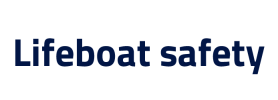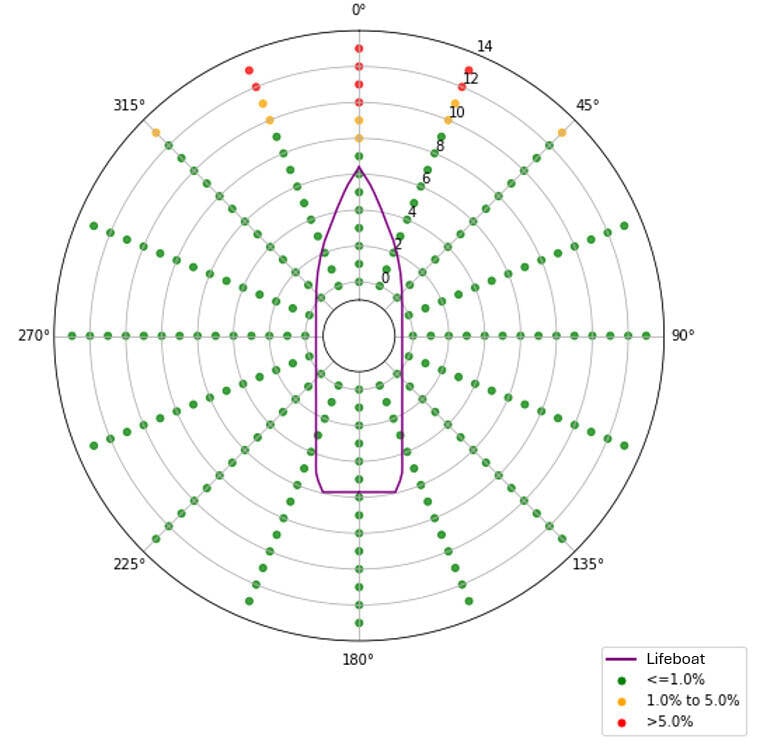“For VIKING Norsafe the ability to predict behaviour of lifeboats in any given condition and sea state, defined by a 99 percentile in a 100-year sea state, is vital to give proof of compliance to these strict requirements, especially regarding offshore projects. VIKING can offer simulations of the lifeboat behaviour as a service, either for newbuilds or existing applications of our product, which gives us a competitive edge and the ability to remain a preferred supplier for life-saving appliances (LSA) equipment.
Flag states and offshore safety regulators have become aware of the potential and gained knowledge by applying this tool to site and host specific evaluation of safety cases for evacuation to sea level. This means that more and more geographic regions require DropXMF or DavitXMF data and instruct operators to explore the operational limitations this way.
When VIKING receives a typical DropXMF or DavitXMF delivery from MARIN, the VIKING project delivery team will analyse the result and clearly determine the possible safety limitation. These so-called operational limitations will show the probability of exceeding a certain threshold and in which wind, wave and current direction this occurs. By looking into this, mitigations are suggested on how to handle these cases, which basically transfers the data to a day-to-day tool that is used on the offshore installations for risk analysis based on weather forecasts.
The VIKING-MARIN cooperation has been extremely fruitful for VIKING. Supported originally by Statoil, and its vision for this safety critical documentation until 2014, the following decade until now has been spent adapting and improving the tools. Cooperating with the dedicated team at MARIN is extremely easy, flexible and always positive when VIKING introduces new requirements or questions from operators. Quality and kept promises are generally on a very high level which is important with these types of clients. VIKING hopes to be in this position for a long time to come, and new simulation environments for Marine Evacuation Systems/Raft and Fast Rescue Craft are being explored. Furthermore, transferring the simulations from the XMF environment to the new Simulation Centre for training and visualisation purposes and understanding, is hopefully in our immediate future.”

Erik Mostert
Innovation Manager Boats and Davits, VIKING Norsafe









October 2024, no. 141
www.marin.nl/sosc

More info
Interested? Contact us to discuss your options
Create a MARIN account to stay updated

Lifeboat certification requirements (DNV SE 0059) dictate that operators must demonstrate that each installed lifeboat can be used safely for a specific platform and site. To demonstrate the safe use of lifeboats, MARIN has developed DropXMF (for free-fall lifeboats) and DavitXMF (for davit launched lifeboats).
The numerical model is used to perform simulations for different weather conditions. In a typical project, 1,000 simulations are conducted per irregular wave height (Hs), based on site specific metocean conditions. During each individual simulation, MARIN monitors whether a collision between the lifeboat and host has occurred, and if the lifeboat was able to sail away within the time limit. The result of these 1,000 simulations is summarised as a single dot in a polar plot, indicating that there is a low risk (green), medium risk (orange) or high risk (red) of non-compliance. These simulations are conducted for multiple wave heights and wave directions, and a typical result is demonstrated below, where one polar plot shows the results for one lifeboat.
One important safety criterion for certification is the safe sail, which takes two factors into account. Firstly, the lifeboat must not collide with the platform (or exceed a certain threshold velocity during the collision), and secondly, the lifeboat must be able to sail sufficiently far away from the platform within a one-minute timeframe.




Report
Quantifying lifeboat safety using DropXMF and DavitXMF
Lifeboat launch in DavitXMF. The lifeboat is lowered with hoisting wires. When the lines are slack, the hoisting wires are disconnected and the lifeboat sails away.
c
We also develop numerical methods to further enhance lifeboat crew training, for example boarding lifeboats and lifeboat pilot training.


Figure 1: Example of a polar plot that summarises the results of a DropXMF project for one lifeboat and different environmental directions and wave heights.
Recently, MARIN has extended the capabilities by including wind shielding from the host using CFD calculations by using our CFD code ReFRESCO.
The output of these simulations is the local wind field around the host, which is used as input for the lifeboat simulations. The result is a much more accurate representation of the wind forces, which is especially relevant for davit launched lifeboats.
We are continuously working on improving lifeboat modelling. Some recent developments include wave shielding from the host, releasing the lifeboat from a moving host, and investigating the influence of wind, waves and current from multiple directions instead of co-linear conditions. Simultaneously, we are developing numerical methods that can be used at the new Seven Oceans Simulator centre (SOSc), which will allow us to further enhance lifeboat crew training. Examples could include boarding lifeboats and lifeboat pilot training.
MARIN continually works on improving the safety of lifeboats and more than a decade ago, we joined Statoil (now Equinor) and Norsafe (now Viking Norsafe) to develop DropXMF and DavitXMF. The development entailed model tests for multiple lifeboat types in calm water and waves, for various drop heights, skid angles, wave phasing relative to the point of impact of the lifeboat and wave heights. In addition, Computational Fluid Dynamics (CFD) calculations were performed to determine wind coefficients for different lifeboats. Full-scale trials were also carried out to examine the lifeboat’s sailing performance, and full-scale drop tests were executed to validate the results and numerical models.
Based on this extensive dataset, a numerical model was created computing the lifeboat motion in the time domain. This initial prototype has been further developed in the MARIN XMF framework. Forces that are considered are the wave forces depending on the wave orbital velocity, buoyancy forces depending on the instantaneous wave profile along the hull, resistance forces of the lifeboat in water and air, and forces from the propeller and rudder which are controlled by a modelled autopilot system, amongst others.



Lifeboat launch in DavitXMF. The lifeboat is lowered with hoisting wires. When the lines are slack, the hoisting wires are disconnected and the lifeboat sails away.
“For VIKING Norsafe the ability to predict behaviour of lifeboats in any given condition and sea state, defined by a 99 percentile in a 100-year sea state, is vital to give proof of compliance to these strict requirements, especially regarding offshore projects. VIKING can offer simulations of the lifeboat behaviour as a service, either for newbuilds or existing applications of our product, which gives us a competitive edge and the ability to remain a preferred supplier for life-saving appliances (LSA) equipment.
Flag states and offshore safety regulators have become aware of the potential and gained knowledge by applying this tool to site and host specific evaluation of safety cases for evacuation to sea level. This means that more and more geographic regions require DropXMF or DavitXMF data and instruct operators to explore the operational limitations this way.
When VIKING receives a typical DropXMF or DavitXMF delivery from MARIN, the VIKING project delivery team will analyse the result and clearly determine the possible safety limitation. These so-called operational limitations will show the probability of exceeding a certain threshold and in which wind, wave and current direction this occurs. By looking into this, mitigations are suggested on how to handle these cases, which basically transfers the data to a day-to-day tool that is used on the offshore installations for risk analysis based on weather forecasts.
The VIKING-MARIN cooperation has been extremely fruitful for VIKING. Supported originally by Statoil, and its vision for this safety critical documentation until 2014, the following decade until now has been spent adapting and improving the tools. Cooperating with the dedicated team at MARIN is extremely easy, flexible and always positive when VIKING introduces new requirements or questions from operators. Quality and kept promises are generally on a very high level which is important with these types of clients. VIKING hopes to be in this position for a long time to come, and new simulation environments for Marine Evacuation Systems/Raft and Fast Rescue Craft are being explored. Furthermore, transferring the simulations from the XMF environment to the new Simulation Centre for training and visualisation purposes and understanding, is hopefully in our immediate future.”

Erik Mostert
Innovation Manager Boats and Davits, VIKING Norsafe
c
Recently, MARIN has extended the capabilities by including wind shielding from the host using CFD calculations by using our CFD code ReFRESCO.
The output of these simulations is the local wind field around the host, which is used as input for the lifeboat simulations. The result is a much more accurate representation of the wind forces, which is especially relevant for davit launched lifeboats.
We are continuously working on improving lifeboat modelling. Some recent developments include wave shielding from the host, releasing the lifeboat from a moving host, and investigating the influence of wind, waves and current from multiple directions instead of co-linear conditions. Simultaneously, we are developing numerical methods that can be used at the new Seven Oceans Simulator centre (SOSc), which will allow us to further enhance lifeboat crew training. Examples could include boarding lifeboats and lifeboat pilot training.
The numerical model is used to perform simulations for different weather conditions. In a typical project, 1,000 simulations are conducted per irregular wave height (Hs), based on site specific metocean conditions. During each individual simulation, MARIN monitors whether a collision between the lifeboat and host has occurred, and if the lifeboat was able to sail away within the time limit. The result of these 1,000 simulations is summarised as a single dot in a polar plot, indicating that there is a low risk (green), medium risk (orange) or high risk (red) of non-compliance. These simulations are conducted for multiple wave heights and wave directions, and a typical result is demonstrated below, where one polar plot shows the results for one lifeboat.
We also develop numerical methods to further enhance lifeboat crew training, for example boarding lifeboats and lifeboat pilot training.

October 2024, no. 141
Interested? Contact us to discuss your options
Figure 1: Example of a polar plot that summarises the results of a DropXMF project for one lifeboat and different environmental directions and wave heights.
Quantifying lifeboat safety using DropXMF and DavitXMF
MARIN continually works on improving the safety of lifeboats and more than a decade ago, we joined Statoil (now Equinor) and Norsafe (now Viking Norsafe) to develop DropXMF and DavitXMF. The development entailed model tests for multiple lifeboat types in calm water and waves, for various drop heights, skid angles, wave phasing relative to the point of impact of the lifeboat and wave heights. In addition, Computational Fluid Dynamics (CFD) calculations were performed to determine wind coefficients for different lifeboats. Full-scale trials were also carried out to examine the lifeboat’s sailing performance, and full-scale drop tests were executed to validate the results and numerical models.
Based on this extensive dataset, a numerical model was created computing the lifeboat motion in the time domain. This initial prototype has been further developed in the MARIN XMF framework. Forces that are considered are the wave forces depending on the wave orbital velocity, buoyancy forces depending on the instantaneous wave profile along the hull, resistance forces of the lifeboat in water and air, and forces from the propeller and rudder which are controlled by a modelled autopilot system, amongst others.
Create a MARIN account to stay updated





Report
One important safety criterion for certification is the safe sail, which takes two factors into account. Firstly, the lifeboat must not collide with the platform (or exceed a certain threshold velocity during the collision), and secondly, the lifeboat must be able to sail sufficiently far away from the platform within a one-minute timeframe.
Lifeboat certification requirements (DNV SE 0059) dictate that operators must demonstrate that each installed lifeboat can be used safely for a specific platform and site. To demonstrate the safe use of lifeboats, MARIN has developed DropXMF (for free-fall lifeboats) and DavitXMF (for davit launched lifeboats).








